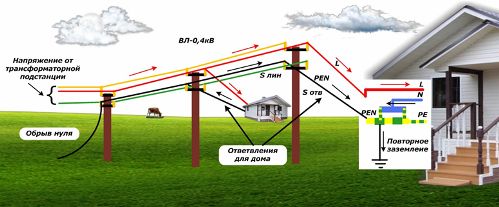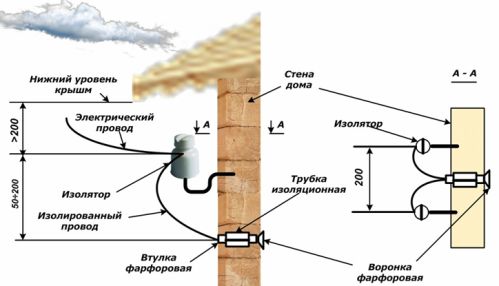Categories: Featured Articles » Electrician at home
Number of views: 53138
Comments on the article: 3
How to enter electricity into a private house
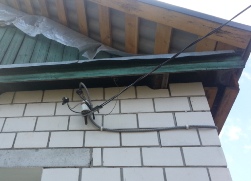 Most often in settlements where private houses predominate, overhead power lines are used. However, cable underground lines can also be used.
Most often in settlements where private houses predominate, overhead power lines are used. However, cable underground lines can also be used.
Part of such a line from the nearest support to the entrance to the house is usually called a branch. It can be laid through the air or underground. Legislatively determined that the branch is owned by the owner of the power line. Maintenance, operation and reconstruction of the branches are his responsibility. Independent work without the consent of the owner of the power transmission line is prohibited.
To create a new branch and connect it to the input of the building, you must have a project that must be agreed with the representatives of the line owner before starting work. The document should reflect a list of all technical solutions and materials.
If it is difficult to do the branching on your own, then you should conclude a contract with the energy supply organization to connect the building to the power transmission line and pay for the provision of the service.
According to the old rules, branches for private houses with a single-phase circuit were performed by two conductors:
-
L - phase;
-
PEN - zero combined.
Three-phase circuits used 4 conductors: three phase (L1, L2, L3) and one combined zero.
Existing operating rules require the splitting of the combined PEN neutral conductor at the entrance to the house at:
-
worker N;
-
protective RE.
For this, artificial grounding conductors are used, which additionally increase the safety of the operation of power lines and do not contradict the requirements of the current rules.
Connecting a house input to an overhead power line
The cleavage site can be selected on the nearest power line support or in the electrical switchboard of the house. This technology is described in the article. "The principles of operation of grounding systems for buildings TN-C and TN-C-S".
When performing splitting inside the building, it is necessary to take into account the likelihood of a break or burning off of the zero conductor at the power line. The figure below clearly shows that in case of an emergency, an electric current from all the nearest connections will flow through the installed re-grounding of the house.
The scheme of operation of the 0.4 kV OHL branch for a private house with re-grounding when the line breaks off zero (click on the picture to enlarge)
In this situation, the load on the branch wire of the PEN conductor will increase significantly, it will become very hot and may burn out. This can be eliminated by using high-power wires that can withstand the same current load as power lines.
For this purpose, for a branch PEN conductor, a wire with a cross-sectional area S equal to the same value for the wire line S line is selected.
When splitting the PEN conductor directly on the VL support for the home owner, this task is simplified, and there is no need to make a large supply of wire thickness. They can be reduced to reasonable limits, ensuring the normal flow of the load current. But to the switchboard of the house will have to pull three cores, not two for a single-phase circuit and five, not four for three phase circuit.
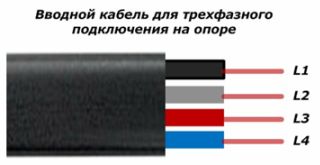
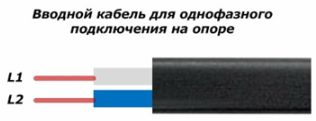
The composition of the cable conductors for connection to the branch with re-grounding on the support according to the scheme TN-C-S
The transition from the TN-C system to the TN-C-S is determined by the location of the PEN conductor splitting circuit.
To connect buildings according to the TN-C scheme, re-grounding and splitting of the PEN conductor is not performed, and the number of cores in the cable is reduced by one.
Connecting a house input to an underground cable power line
All the principles of the electrical circuit, considered for an overhead power line, fully comply with the requirements for connecting to cable lines. The differences are in the methods of arrangement and mechanical connection of the components of the mounted section. Commutation of the veins of the branch cable to the underground line is carried out in a special metal cabinet.
For its installation, it is necessary to fulfill the foundation, which ensures the stability of the structure during soil deformation during freezing in winter and in the conditions of autumn-spring thaw.
The cabinet material and construction must meet the requirements of increased strength in order to withstand attempts by vandals to penetrate electrical equipment. To this end, it is recommended that such cabinets be raised to a height of more than two meters. The same cabinets are often located on the poles of overhead lines.
All work on the overhead power line and underground cable line, including the installation of branches, are carried out exclusively according to the approved project by the local service organization. Self-made connections are strictly prohibited and life-threatening!
Design features of the air branch
The wires of the electrical circuit are fixed to the supports through porcelain, glass or polymer insulators. In the case of using self-supporting SIP cables, special fasteners are used, which are sold together with the cables. When placing a branch, it is important to maintain all distances ensuring the safe use of electricity.
Design features of the air branch (click on the picture to enlarge)
If the distance from the nearest support to the entrance to the house exceeds 25 meters, then it is necessary to install an additional support as an intermediate. When the wires are located above the carriageway, the minimum sagging of the lower wire should not be less than 6 meters.
If it is necessary to arrange the cables above the tracks, they must be mounted at a height exceeding 3.5 meters. The location of the insulators on the wall of the house is chosen so that the wires attached to them are placed above the ground not less than 2.75 meters. Growing trees and even shrubs under electrical wires is unacceptable.
Above the fixed insulators there may be roof elements, a balcony and other architectural structures. The distance from them to live parts must exceed 0.2 m. To connect insulated aluminum wires to the line, twist or special clamps are used.
Rules for installing branches with separate wires
Entering the wires of an overhead overhead line into a wooden building
This method was widely used before the sale of self-supporting insulated CIP cables. For its use, the passage through the wall is made by an insulated wire, which is additionally separated from the wall by a porcelain sleeve, a funnel and a semi-solid insulating tube made of rubber or polyethylene.
Each wire of the circuit is fixed to its insulator installed near the inlet. It can be made common to all wires, but their laying must be done in separate insulated pipes. Insulators on the wall of the house should be separated from each other by at least 20 cm.
Cable Installation Rules
For low buildings, pipe support is used and cable entry is performed through the roof.
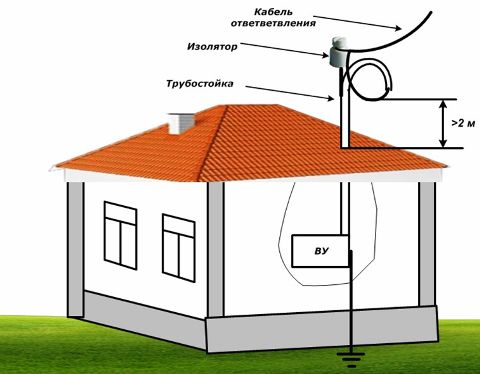
Scheme of organization of cable entry into a low structure
With this method, it is necessary to ensure that the cable is removed from the roof by 2 meters or more. Steel pipe rack is required to be connected to the ground loop of the house.
In some cases, it is convenient to use a fake post.

Diagram of the organization of cable entry using an extension pole
In this case, it is also recommended to run the cable down the pole in a steel pipe.
With any connection method, the branch wires or cable must be intact, without breaks or connections.They must be connected at one end to the line insulators, and at the other end directly to the terminals of the input automatic machine for switching to the electric meter.
Installing an introductory device
The long trunk lines connect many consumers with a transformer substation. When transporting electric energy, switching loads constantly occur, accompanied by transients, power swings, fluctuations in currents, voltages, and frequencies.
During a thunderstorm, there is a chance that lightning energy will enter the overhead power lines. All these malfunctions are designed to eliminate the protection of the line, but until the moment of their operation, the wiring of the house can be damaged.
Therefore, between the power line and the switchboard of the house, it is necessary to mount another cabinet that performs the function of protecting the building’s electrical equipment from abnormal penetration into the electrical wiring periodically occurring on the power line. It is called an introductory device. It contains:
-
a powerful circuit breaker or replace it with an ordinary circuit breaker of the RB-31 series type with a set of fuses equipped with powerful fusible inserts rated for currents of about 100 A;
-
arresters or surge arrestersprotecting against the penetration of high lightning potential;
-
PEN splitting circuit of a conductor connected to re-ground.
The figure below shows the design of a three-phase input device. For a single-phase circuit, it is simplified by using elements of only one phase.
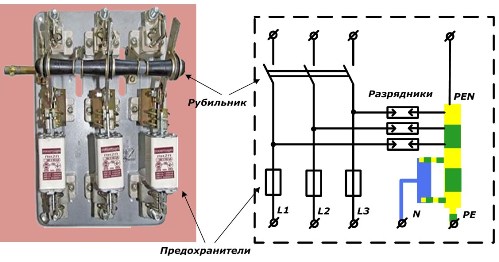
Input device design
The input device can be placed directly on the support of the overhead power line or on the wall of the house from the outside. Its design for connecting to underground cable lines is designed in the same way as for overhead lines.
The presence of re-grounding in the house requires the installation of lightning protection and an SPD system.
In conclusion, please note again that all work on power lines and their supports is allowed to be performed only by trained and authorized personnel of the organization to whom this electrical equipment is assigned.
Read also on this topic:How to upgrade the electrical panel in a private house
See also at bgv.electricianexp.com
:

